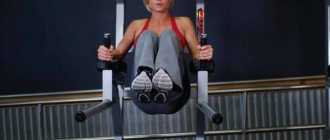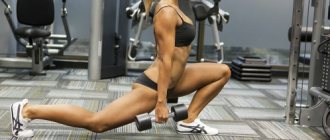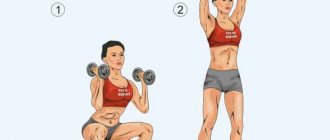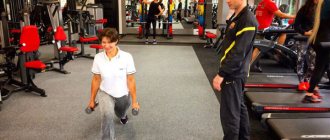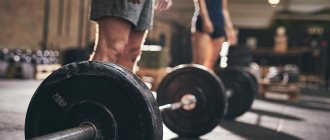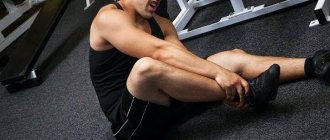Any athlete, making even the most seemingly harmless movements, armed with minimal weights, runs the risk of injury. At best, tendons and ligaments suffer, but one cannot discount the bones, which are also at risk. Bodybuilding is different in that here joints and bones are injured much less frequently, since you have to deal with weights, where there are practically no different accelerations, such as in football or hockey, as well as other dynamic sports games, where joints and bones suffer more. In bodybuilding and powerlifting, injuries mainly occur in the form of sprains or dislocations. For example:
- Sprains are associated with damage to the ligaments and tendons, which leads to their deformation, stretching and even rupture.
- Dislocations lead to disruption of the normal functioning of the joints, which leads to a loss of normal functioning of the surfaces relative to each other.
What are sports injuries
Sports injuries are not so common; out of 10 thousand athletes, about 50 people are injured. However, you should not underestimate the injuries received, because often it is precisely this kind of damage caused to health that causes the end of the careers of the most famous athletes.
More common are bruises, ligament damage and abrasions, accounting for about 80% of all injuries. The second place in occurrence is occupied by limb fractures and dislocations (3%).
The types of injuries sustained are specific to each sport. Thus, the most common bruises can rarely be seen in swimmers and skiers, but they are typical for hockey players, football players and boxers. Muscles and tendons most often suffer from gymnasts, weightlifters and track and field athletes, while sprains occur most often in wrestlers, champions of sports games and representatives of rhythmic and artistic gymnastics. Cyclists, hockey players and speed skaters are most often susceptible to fractures.
The types of injuries sustained are specific to each sport.
There is not a single sport in the world that does not pose a danger to human health. Even playing chess is fraught with problems with the muscles of the neck and back and headaches.
Hockey is among the leaders among traumatic sports
The specificity of sports injuries is that the musculoskeletal system is primarily affected. People who play sports professionally often know the technique of falling well, and their injuries are limited to soft tissue bruises and fractures of small bones, and more severe injuries are the exception to the rule.
The most dangerous sports areas are those where a person receives physical activity in unusual conditions: diving and diving to depths, climbing mountains.
In an environment unusual for the body, even minor organ dysfunctions become aggravated, attention is distracted, which reduces the speed of reaction in dangerous situations
Sports injuries include not only injuries received directly during competitions or training, but also as a result of prolonged sports activities.
Video: osteopath Ladosha on the problems of sports injuries
We take into account the condition of the joints
When deciding to go to the gym, you need to take your age and body size into account. At the age of 20, the condition of the joints and cartilage allows you to engage in almost any kind of sport. And if you are overweight, even in everyday life the pressure on the joints exceeds the normal level, not to mention working out in the gym. It is necessary to take into account the fact that after 40 years, joints are no longer the same as at 20. Therefore, vertical loads, especially without prior preparation, are especially dangerous. For people who have reached the age of forty or are overweight, moderate cardio exercise, cycling, exercise on an elliptical trainer, walking, exercise in the pool, Pilates, and stretching are recommended.
https://youtu.be/uhOUqpbbblQ
Classification of sports injuries
Injuries received in sports activities are divided according to their origin, severity, time of occurrence and type of damage. In the first case, 3 groups are distinguished:
- Primary injuries. Caused by non-compliance with safety regulations or incorrect movement. This group includes ligament damage, bruises, muscle strains, bone and skull fractures.
- Repeated injuries. They occur from insufficient duration of the rehabilitation course or incorrect treatment of the primary injury.
- Injuries caused by overload. Especially typical in childhood. The child’s bones and muscles are not able to withstand long-term loads, as they are in the formative stage. Overuse injuries are specific and common, so they are given characteristic names: “jumper’s knee,” “tennis elbow,” “swimmer’s shoulder,” “boxer’s knuckle,” etc.
There are 5 types of sports injuries based on severity:
- Microtraumas. The consequence of such harm to health is the limitation of training for 1 day. Typically this type includes microtraumas of the skin (splinters, abrasions, scratches) and minor bruises.
- Minor injuries. These include minor damage to the skin or soft tissue. After injury, the restriction of physical activity is 7–10 days.
- Moderate injuries. They require medical care: bandaging, bandaging, plaster casting. Rehabilitation in this case is longer and takes up to a month. This type of injury includes hematomas, closed fractures, severe bruises, sprained ligaments and muscles.
- Serious injuries. Treatment of such injuries is carried out in a hospital setting under the supervision of specialists: orthopedic doctors, traumatologists, surgeons. Treatment is immediate and often requires first aid measures. Such injuries include severe dislocations and fractures, spinal injuries and traumatic brain injuries.
- Fatal injuries. They are found in the most dangerous sports, such as base jumping, deep-sea diving and freediving, downhill skiing, rock climbing, windsurfing, etc.
Climbers risk falling from great heights, fractures and open injuries, dislocations, as well as severe hypothermia of internal organs and limbs
Based on the time of occurrence, sports injuries are divided into two types:
- Acute - injuries received suddenly during training or other physical activity (fracture, dislocation, sprain).
- Chronic - injuries that develop over a long period of time. The reason for this may be force overload, a sharp increase in the number of workouts and their duration (for example, this type includes tendonitis - inflammation of the tendon).
There is also a classification of injuries according to the parts of the body in which the injury occurred. The most typical injuries have been identified for each sport.
The classification of injuries is conditional; athletes often receive several types of injuries at the same time.
Table: classification of injuries by body part
| Injured body part | Common types of sports injuries | Sports for which such injuries are more common |
| Head and face |
|
|
| Shoulders |
|
|
| Elbows |
|
|
| Hands |
|
|
| Spine |
|
|
| Ankles |
|
|
| Knees |
|
|
| Feet |
|
|
Damage to the shoulder joint
Shoulder injuries in sports occur due to non-compliance with safety precautions when performing exercises. The reason is the incorrect development of training complexes.
When starting physical training, you need to make sure that all heavy elements are securely secured. An athlete lifting heavy weights must be prepared for this.
Injuries occur in situations:
- Overstrain of the shoulder joints.
- Rupture of the cartilage ring, which is located along the socket of the joints.
- Sprains.
Injuries can occur when performing knee exercises after an injury:
- Lifting the barbell while lying down.
- Lifting the barbell from behind your head.
- Pulling towards the chest.
Dangerous injuries include shoulder dislocation. A sharp pain appears, the joint changes its shape, and a crunching sound is heard when moving. The patient cannot move his arm.
A fracture of the collarbone is less common. Treatment is carried out by applying a fixing bandage, possibly using plaster.
In bodybuilding, athletes experience shoulder muscle dislocations and strains. Bursitis can develop with heavy physical exertion. It manifests itself as pain and swelling in the area of injury.
Medical intervention when a problem is detected
If an injury occurs, you must stop training, fix your hand in one position and apply ice.
When the shoulder joint is dislocated, it is adjusted by specialists under local anesthesia.
Fractures are treated by applying a cast. For bruises, apply a bandage to the patient, cooling the bruise site.
How long will it take to recover?
The damaged joint should not be stressed for 2 weeks. To reduce pain, the drugs Ketanov and Ibuprofen are prescribed.
You can start training when the feeling of discomfort in the damaged area completely disappears.
Training should be carried out according to a strict scheme:
- The first days, do a light warm-up, with a predominance of circular movements.
- Weight loads are increased gradually. The course of increasing the load lasts at least 15 days. In difficult cases it increases to 40.
An important point in recovery is the introduction of supplements into the diet to strengthen ligaments. The athlete must take preventive courses at least once a year.
The prognosis is favorable.
Causes of injury
Despite the centuries-old history of sports, it is completely impossible to avoid injury. The risk of injury is high for both a beginner and a professional with many years of experience. Trainees mainly suffer from chronic injuries caused by repetitive stress and the specific nature of the sporting activity. Often the cause of damage is the athlete's overwork, insufficient physical training and bad habits. In elite sports, the use of doping drugs can also cause injury.
In addition, the causes of common injuries include:
- poor-quality equipment, clothing and shoes of the athlete, as well as an unsuitable area for playing sports;
- improper organization of training and competitions;
- weather conditions unsuitable for sporting events;
- inadequate sanitary conditions for sports;
- lack or insufficient provision of medical care;
- violation of sports discipline.
Dislocation of limbs
Elbow injuries in bodybuilding are most common when working with machines. Knee dislocation is less common.
- When a dislocation occurs, the joint becomes deformed and swelling or hematoma occurs. Moving the injured limb causes pain, and resistance and sometimes numbness are felt.
- The reason is the desire to lift a lot of weight, a malfunction of the simulator and non-compliance with the execution technique.
- After receiving an injury, immobilize the joint and immediately contact a traumatologist. It is better to get to the hospital in the first half hour.
- You can return to sports in 2 months.
- To avoid problems, train the muscles that press the joint surfaces together.
Symptoms and signs of post-workout injuries
It is believed that soreness (muscle pain, usually appearing within a day, sometimes several hours after physical activity) is a natural process.
Delayed muscle pain occurs due to irritation of nerve receptors by metabolic products, including lactic acid.
However, there are types of pain that serve as a sign of injury and a signal that there is a danger to the athlete’s health. The most common and alarming symptoms after training are:
- severe pronounced tremors in the muscles. This is a signal about the need to take a break, indicating hypertonicity of the athlete’s muscles and fatigue. With a further desire to continue training, the athlete risks getting a more serious injury, for example, a muscle strain or rupture;
The injury can be manifested by pain of varying intensity, soft tissue swelling, hyperemia, increased local temperature, loss of mobility and other symptoms
- sharp sharp pain. There can be many reasons for sudden pain: muscle rupture;
- ligament rupture;
- dislocation;
- joint damage, etc.;
Elbow, forearm, wrist and hand injuries
These parts of the hand perceive loads of varying directions and intensity, make many powerful and precisely coordinated movements, and take on shock loads when falling and performing vaults. Therefore, according to statistics, they account for more than 50% of all injuries.
"Tennis Elbow"
This is a violation of the integrity of the fibers of the flexor muscles of the hand at the junction with the outer side of the humerus.
Pain syndrome occurs in the elbow joint, which intensifies with extension or strain on the arm. The sensitivity of certain areas of the forearm worsens, muscle weakness and limited movement appear.
In mild forms of damage, to restore full functionality, it is enough to eliminate stress on the elbow and use: joint massage, warming procedures, anti-inflammatory drugs. Acute and advanced cases require accurate diagnosis and treatment in a medical facility.
© Alila-Medical-Media — stock.adobe.com
Effective warming up of the muscles during warm-up, dosed strength loads on the forearm muscles and regular use of relaxing procedures (massage, sauna) help prevent such injury.
Ulnar neuropathy
These are various options for dysfunction of the ulnar nerve.
A small painful area appears in the elbow joint, which gradually expands and spreads to the palm and inner surface of the fingers, their sensitivity decreases and extension becomes difficult, and hand movements are limited.
Prolonged stationary position of the elbow under load, dislocations and fractures of the forearm bones, bruises and sprains are the main causes of this neuropathic lesion.
In cases of minor damage to the ulnar nerve, anti-inflammatory ointments, dry heat and light massage of the joint are used. For acute symptoms, treatment is prescribed only by a doctor.
Reducing the duration of static load on the elbow and performing special exercises to strengthen the muscles and stretch the tendons of the elbow joint reduces the risk of developing the above pathology.
Elbow fracture
This is an extra-articular or intra-articular fracture of one of the three bone fragments of the elbow joint.
Pain syndrome immediately occurs in the elbow. Depending on the type of damage, it can be severe or mild. Swelling appears and joint mobility is lost.
Such a fracture occurs when falling on the elbow or a direct blow to the joint area.
It is necessary to immobilize the injured limb and immediately ensure the delivery of the victim to the emergency room.
© praisaeng — stock.adobe.com
To prevent fractures during training and competition, you must always use appropriate protective equipment.
Carpal tunnel syndrome
This is a disruption of the normal functioning of the median nerve as a result of its compression in the carpal tunnel.
At the first stage of the disease, pain and numbness occur in the fingers at night. Then the pain begins to appear during the day, intensifies with hand movements and begins to spread to the palm and forearm. Grasping functions become difficult.
The main causes of injury are bruises, sprains, dislocations and fractures of the bones of the hand.
© Alila Medical Media — stock.adobe.com
First of all, it is necessary to ensure complete rest of the injured limb for at least two weeks. Cold and anti-inflammatory compresses are used to eliminate swelling.
In severe cases, long-term medication or surgery may be required.
Choosing the correct hand position when performing physical exercises and reducing the duration of loads in a fixed position of the hands helps reduce the likelihood of developing carpal tunnel syndrome.
Methods for diagnosing injuries
The diagnosis is based on the patient’s medical history, examination and the use of instrumental methods (if it is necessary to examine more severe injuries or to clarify the conclusion). During the examination, you should find out the circumstances of the injury and describe the execution of the movement that contributed to the injury, clarify the time of pain onset, the nature of its severity during physical activity and after.
X-rays are most often used to diagnose sports injuries - an accessible and informative method.
Additional diagnostic methods include:
- radiography is the most common study of sports injuries; it helps in the differential diagnosis of limb fractures and dislocations, sprains, severe bruises, etc. Informative only for hard structures;
- CT (computed tomography) - especially useful for diagnosing closed head and abdominal injuries;
- MRI (magnetic resonance imaging) - makes it possible to study all the tissues in the diagnosed area, talk about changes not only in bone tissue, but also in muscles, ligaments, tendons, nerves and blood vessels;
- encephalography is a method that helps in diagnosing the brain in cases of traumatic brain injury;
- Ultrasound - the study helps to determine both muscle damage, in particular rupture, and disorders of internal organs;
- laparoscopy (minimally invasive surgery using an optical device that allows you to examine organs from the inside) is indispensable in diagnosing abdominal organs.
How not to work out in the gym
Many men who decide to become handsome muscular men go straight from the gym to the traumatologist’s office.
American scientists have found out which injuries are the most common and what leads to them. Thousands of sports club visitors are injured every day in the name of strength and beauty. Ignorance of safety rules and the wrong approach to exercise lead to a huge number of traumatic situations. Experts from the USA decided to look at this problem in numbers, for which they involved in their research visitors to “rocking chairs” aged 25-34 years. As a result, it turned out that the torso area is most often injured – 28%. Then come the hips - 24%, hands - 15%, feet - 13%, head - 11%, arms - 5%, legs - 4% and other parts of the body - 1%.
As for the type of injury, the most common are sprains - 52%. Soft tissues are damaged in 16% of cases. Cracks, fractures and dislocations account for 10% of complaints, muscle rupture occurs in 7% of cases, concussion in 0.2%, hemorrhage in 0.1% and other injuries in 14% of cases.
Most injuries occur when a student drops a heavy projectile on himself - 66%. Overexertion can be blamed for 9% of accidents, and the same number of injuries occur as a result of being caught between weights. 8% of victims injure themselves, 5% lift weights incorrectly, and 3% lose their balance or fall.
Experts warn that before you engage in strength exercises, you need to clearly understand all the safety rules, and, if necessary, do not hesitate to seek help from a specialist.
Treatment
The intensity and duration of treatment is determined by the severity of the injury. The therapy may be limited to applying cold to the injury site and taking painkillers, but there are also extremely severe cases when the athlete is forced to undergo surgical treatment.
The following symptoms require immediate medical attention:
- acute pain both during movement and at rest;
- inability to walk or bear weight on the injured limb;
- the appearance of swelling in a previously injured area;
- feeling of instability in the joint;
- open wound or fracture;
- intense blood loss.
Getting injured often requires bed rest or stopping training for a period determined by the doctor. Continuing sports activities through pain can significantly aggravate the situation.
First aid
Timely provision of first aid serves to prevent the deterioration of the victim’s condition and the development of serious complications. If necessary, you should first call a medical team.
Bruises, sprains, dislocations
In case of soft tissue injury (bruises, sprains), as well as dislocations, first medical assistance should be provided in the following order:
- Apply cold to the damaged area for a quarter of an hour.
- Bandage the injured limb tightly.
The best thing to do is to stop training, immobilize the injured limb, and apply cold to the stretch.
- Cold should be applied again over the elastic bandage for a longer time, from one and a half to two hours.
- Place the injured area of the body in an elevated position.
- If necessary, give the victim a pain reliever (Paracetamol, Ibuprofen, Analgin).
If a limb dislocation is suspected, it is necessary to immobilize it in the position acquired during the process of bone displacement. It is forbidden to adjust a dislocation yourself!
Bone fractures
For bone fractures, first aid is provided in the following order:
- In the area of the fracture, it is necessary to create conditions for the immobility of the damaged bones. This will reduce pain and prevent the victim's condition from worsening.
- Assist in transporting the victim to the hospital.
Immobilization of the fracture site is created by applying a splint made of hard material at hand (boards), or by bandaging the damaged part of the body to a healthy one. In this case, it is necessary to fix the joints between which the injured area is located.
Immobilization is the most important component of first aid for a fracture.
In case of an open fracture, pre-immobilization measures must be taken to stop the bleeding: apply a pressure bandage or tourniquet. Afterwards, the wound should be covered with a clean, preferably antiseptic, cloth. Proper fixation of the injured limb is the best help to prevent the development of a state of shock.
Head injuries
The primary action is to provide rest to the victim in a supine position, or in case of loss of consciousness - on his side. Afterwards, a cold compress or ice is applied to the head.
Spinal fracture
The victim is placed on a flat and hard surface (board, door, boards), which is then used for transportation to the hospital. If the necessary boards or suitable stretchers are not available, it is safer to move the patient in the prone position.
If a spinal fracture is suspected, do not sit or stand the victim on his feet!
Bleeding
The most common injuries among athletes are those accompanied by nosebleeds. In this case, you should make sure that there is no fracture, then sit the victim so that his back is straight, and press the wings of the nose against the septum with your fingers for 5–10 minutes. If this does not help, you need to insert a cotton swab pre-moistened in a salt solution into each nasal passage. If all attempts to stop the nosebleed are futile, transport the victim to the hospital.
You should not throw your head back if you have a nosebleed, as blood entering the mouth can pose a threat to the respiratory tract.
For other bleeding resulting from injury to blood vessels, the bleeding should be stopped using a tourniquet, a pressure bandage, or pinching with fingers a place located 5 cm above the site of injury. For small wounds, you should raise the injured limb above the level of the heart, and then treat the wound with an antiseptic.
A tourniquet is applied only in extreme cases (fountain), because it very often causes irreversible damage
Drug therapy
Medicines for the treatment of sports injuries can be divided into two categories: local and complex. The latter are used to relieve severe pain and are prescribed in the first few days after injury. Also, systemic medications help relieve inflammation.
If the injury is of minor or moderate severity, the doctor recommends non-steroidal painkillers, which can be bought freely at any pharmacy (Paracetamol, Ibuprofen, Aspirin, Naproxen, etc.). If over-the-counter drugs are ineffective, more effective and serious drugs are prescribed.
To reduce inflammation and pain, doctors often recommend taking over-the-counter nonsteroidal anti-inflammatory drugs
Topical preparations
Local remedies are widely used in the treatment of moderate sports injuries, such as contusion, hematoma, bruise, sprain, dislocation. This category of drugs, in turn, includes several of the most common types of medications:
- Ointments are the most common means for local anesthesia and inflammation relief. By purpose they are divided into:
- cooling ointments. Applicable at the initial stage of trauma therapy. Analgesics, relieve swelling and inflammation. These include the drugs Bom-Benge, Troxevasin, Menovasin, Menthol ointment, etc.;
- warming ointments. Used to warm up muscles before training. In the treatment of injuries, they are used after three days have passed from the moment of tissue damage to relieve swelling and resolve hematomas. These include medications Capsicam, Finalgon, Nicoflex, Apizartron, etc.;
- ointments and gels that relieve inflammation. Helps reduce swelling of the damaged area, increase blood flow and relieve pain. This group includes Diclofenac, Ibuprofen, Finalgel, Fastum gel, Indovazin, Traumeel, Dolobene, Heparin ointment, etc.
For sports injuries, warming, anti-inflammatory and analgesic ointments are used.
- Plasters are used as pain relievers for bruises, sprains or muscle sprains. The most popular: Voltaren patch, Nanoplast forte, Ketonal thermo.
- Muscle tape is a sports patch that can be used both for the prevention of injuries and for the treatment of sprains. Relieves pain and provides support to the injured area.
Medications - photo gallery
Troxevasin relieves swelling and inflammation
Finalgon is used to relieve swelling and resolve hematomas
Diclofenac relieves inflammation
Nanoplast forte is a pain reliever for bruises, sprained ligaments or muscles
Video: kinesio taping against muscle pain
Physiotherapy and massage
After a sports injury, rehabilitation includes physical therapy, massage and exercise therapy. The procedures should begin after the pain and swelling of the damaged area disappears.
Physiotherapy may include:
- warming up (applying paraffin to the injury site). Relieve pain, improve lymph and blood flow and relieve muscle spasm;
Paraffin applications have found wide application in rehabilitation and conservative treatment of diseases of the musculoskeletal system
- electromyostimulation, which uses weak electric currents on damaged muscles, which increases muscle tone and helps strengthen it;
- electrophoresis, which allows local administration of the necessary drugs. The advantage of the method is a minimum of contraindications and painlessness;
- UHF is a therapy that increases blood circulation at the site of injury and promotes rapid tissue regeneration.
Exercise therapy is an integral part of rehabilitation and contributes to the complete restoration of motor activity. Physical education begins with small doses of load on the damaged area and then increases. Exercises help normalize metabolism, improve blood circulation and strengthen muscles.
All exercises from the exercise therapy complex are performed 2-3 times a week, and in some cases daily
Therapeutic massage is aimed at stimulating metabolism, increasing blood flow and lymphatic drainage, and strengthening muscles. The procedure helps eliminate pain, has a relaxing effect, and improves immunity. Each session consists of four main components: stroking, rubbing, kneading and vibration movements. At the beginning of the course, only the first two elements can be used.
The duration and intensity of therapeutic massage for each patient is selected strictly individually
Surgery
For more severe injuries, such as complete ruptures of ligaments and tendons, complex fractures and traumatic brain injuries, surgical intervention is required. Also, some chronic pathologies may lead to the need for surgery, for example, arthroscopy (performed for tears of the meniscus, ligament or cartilage) or restoration of cartilage tissue.
With the help of arthroscopy, at the current stage of development of surgery, it is possible to perform a number of surgical interventions that were previously done only with the help of arthrotomy (dissection of the joint)
Restoring joints using minimally invasive arthroscopic surgery is possible when tissue damage is no more than 50%. In more severe situations, when tissue destruction is great, it is possible to restore joints using endoprosthetics.
Folk remedies
With a small degree of damage, you can supplement the main treatment of sports injuries with folk remedies.
Clay lotions
Used to treat sprains (muscles, ligaments) in the first hours after injury. Clay is applied to natural fabric in a wide layer and applied to the damaged area for 3 hours. Over time, it dries out and heats up, which requires replacing the lotion with a new one.
Ingredients:
- clay - 100 g;
- apple cider vinegar - 5 tbsp. l.;
- water - 1 l.
Preparing the lotion:
- Take 100 g of clay (can be bought at a pharmacy) and dilute it in 1 liter of water.
- Add vinegar and stir.
- Soak a cloth (for example, linen) in the solution and squeeze lightly.
Aloe compress
The known anti-inflammatory properties of aloe juice help treat sprains and bruises.
Preparation of the compress:
- Finely chop the aloe leaf (the number of leaves depends on the area of the lesion).
- Place the pulp on a clean gauze bandage.
Apply the compress to the injury site for 6 hours, secure with a bandage on top.
Essential oils
Oils are a good help in treating bruises. In order for a bruise from an old injury to go away, you need to rub the damaged area with rosemary oil. If the injury is fresh, it is recommended to use lavender oil.
Cabbage leaves
Many people know a folk remedy for long-standing bruises, bruises and hematomas - cabbage leaves.
Preparation of the compress:
- Rinse cabbage leaves with running water.
- Using a kitchen hammer, beat the cabbage leaves until the juice appears.
Place the leaves on the damaged area, secure the top with clean gauze and leave overnight.
Photo gallery: folk remedies for sports injuries
A compress made from cabbage leaves is extremely effective for varicose veins and inflammation of the joints, bruises and other injuries that are accompanied by swelling.
A popular folk remedy for treating sprained muscles and ligaments are clay lotions.
Lavender oil relieves pain and effectively eliminates swelling, and essential oils of mint and cypress will help stagnant blood dissolve faster
Aloe works well for minor bruises
Knee injury
Knee injuries often occur in bodybuilding athletes.
They occur due to high force loads and joint overloads. Fabrics wear out and become unusable, which is the reason for the appearance of microcracks. Several main areas of the knee joint are susceptible to injury. The ligamentous apparatus suffers; in the case of a mild injury, the ligaments are stretched, in the case of a severe injury, they are torn.
The pain appears immediately, and after a certain period of time it intensifies. Due to the fact that athletes focus on developing the muscles of the front of the thigh, the patellar ligaments are more often damaged.
The joint contains articular cartilage, which serves as a covering and is responsible for the shock absorption function. They are a vulnerable spot for injuries. Violation of their integrity leads to the appearance of chronic pain. Severe cases of damage will cause disability.
Athletes often damage their menisci. These are formations that, together with articular cartilage, act as a lining between the heads of the femur and tibia. When it is damaged, a person feels paroxysmal pain, “jamming” of the joint.
Effective treatment
Treatment of knee injuries is carried out under the supervision of a specialist. Non-steroidal anti-inflammatory drugs are used as therapy. These include Ketanov, Diclofenac, Ibuprofen.
They relieve pain, but do not eliminate the cause of the pain. Peace is important. It is possible to cure a knee injury with sprained ligaments only by limiting physical activity.
When ligaments are torn and sprained, therapy is aimed at reducing pain and swelling. Cold is applied to the injured area and complete rest is ensured.
If the ligamentous apparatus is seriously damaged, surgical ligament repair is possible. Other cases are treated with conservative methods.
Rehabilitation and prognosis for the patient
To speed up your knee recovery, follow these recommendations:
- Take nutritional supplements to strengthen joints and ligaments.
- During the recovery period, wear a bandage on your knee.
- Before training, stretch your knee.
- Perform exercises for knee injuries with low weight and large amplitude.
- Wear comfortable shoes.
- Spend less time on your feet, don't run.
- Take physical therapy courses regularly.
- Follow a diet, eat right.
- Reduce physical stress on the knee. Draw up a training plan with your doctor, taking into account the fact of the injury.
The prognosis is usually favorable, but depends on the extent of the damage. As the joint recovers, loads are added gradually. By following all the instructions, the athlete will be able to reach his working weight.
Possible consequences and complications
The vast majority of sports injuries are not life-threatening. However, a serious disadvantage for athletes is the long rehabilitation period, which forces them to take long breaks in training, lose their previous physical fitness, and miss important competitions. Depending on the severity of the damage to health, the recovery period can take from a month to a year, and in extreme cases, even serve as a reason for ending a sports career.
Thus, when treating bruises, rehabilitation can take from 2 to 5 days, for muscle or ligament sprains - from 2 weeks to a month, after a complex dislocation or fracture, recovery takes up to 3 months, and in the case of a fracture with bone displacement - up to 1 year.
For a faster recovery and a good prognosis, it is necessary to start treatment as early as possible and complete the course of therapy completely. By interrupting the procedures prescribed by the doctor, the athlete can provoke re-injury, which will take an even longer recovery period.
The most severe injuries, as a rule, are spinal injuries and traumatic brain injuries. Predicting the rehabilitation period in these cases is more difficult; treatment always requires mandatory hospitalization and a full examination.
Video: mistakes in injury rehabilitation leading to complications
Damage to articular surfaces (cartilage)
It is a more dangerous type of injury that occurs due to lifting too heavy a weight. In most cases, the spinal column and sacroiliac joints are injured. When they are damaged, a reflex muscle spasm occurs around the lesion. In this way, the muscle tries to naturally protect the joint from further negative effects, but this is accompanied by intense pain and stiffness in movement.
A complete cure will require several weeks and a mandatory visit to a chiropractor who can eliminate muscle spasm and restore joint mobility. In severe cases - surgical intervention.
General tips for preventing injuries in heavy sports
Sports injuries to joints and muscles can happen to anyone, but you can reduce your risk by following these rules:
- Warm up well and for a long time, do not exclude preparatory exercises;
- increase the number of repetitions and weights gradually;
- Perform new (unfamiliar) exercises only with a trainer.
What other recommendations can you give from your own experience to reduce the risk of sports injury? Write to readers in the comments.

